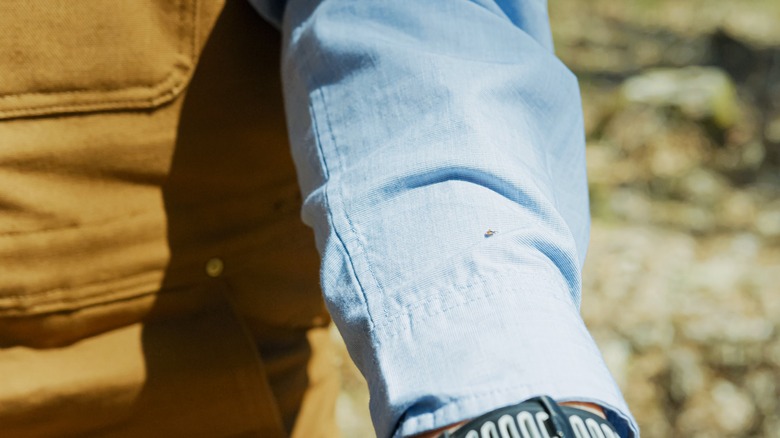Tick Expert Dr. Thomas Mather On How To Prevent Tick Bites And What To Do If You Get Bit - Exclusive Interview
As people start to head outside to enjoy the summer sun and all sorts of outdoor activities, it's important to be on the lookout for ticks. These tiny insects, which can be found in all 50 states, can transmit a variety of diseases when they bite. Because they're so small, ticks are often missed while they're still attached to the skin, and unless a rash develops, a tick bite can go completely unnoticed. That's why it's so important to prevent tick bites before they happen.
It's also really important to do thorough tick checks every time you go to a place where ticks are likely to dwell and take the right actions if you do find a tick on your body. Dr. Thomas Mather, one of the leading tick experts in the nation, took some time to talk to Health Digest about the best ways to avoid tick bites this season, how to do a comprehensive tick check, and the steps you should take to safely remove and deal with any ticks you do find.
Ticks and tick-borne illnesses
Can you tell us a little bit about your background? How did you become one of the nation's leading experts on ticks?
I joined the University of Rhode Island in 1992, coming from the Harvard School of Public Health, and now serve as director of URI's Center for Vector-Borne Disease and its TickEncounter Resource Center. My research focuses on tick ecology, area-wide tick control strategies, tick-bite protection, and tickborne disease prevention. My research and outreach programs are diverse, including anti-tick vaccine discovery projects, evaluations of targeted tick control strategies, tickborne disease risk prediction, as well as development of tick-bite protection decision support tools and social networking strategies for tickborne disease prevention.
My work has attracted funding from a wide variety of sources, including the National Institutes of Health, Centers for Disease Control and Prevention (CDC), the US Department of Agriculture, the National Science Foundation, the Environmental Protection Agency, and the US Agency for International Development. Most recently, I have helped launch the Equip-4-Ticks Resource Center in an effort to help inform the public about best practices for tick protection.
What kind of diseases do ticks transmit?
Ticks can transmit the germs causing Lyme disease and other tick-borne illnesses including Babesiosis, Anaplasmosis, Ehrlichiosis, Rocky Mountain spotted fever, Powassan, as well as other harmful germs and allergens such as Alpha-gal syndrome.
What are the signs and symptoms of Lyme Disease?
Caused by a spirally shaped bacterium transmitted from tick to host, Lyme disease can cause various symptoms and serious side effects, including neurological and heart complications. The most common first symptoms of Lyme disease include a rash, fever, joint aches, and headaches.
Do all types of ticks carry Lyme Disease germs?
No, not all types of ticks carry the Lyme Disease germ, but blacklegged ticks and western blacklegged ticks do.
Can you still have Lyme Disease even if you don't see the classic bulls-eye rash?
Yes! Not everyone gets the bulls-eye rash, otherwise known as, Erythema migrans (EM) rash.
When to do a tick check
Where do most people encounter ticks and get bitten?
Today, ticks can be found in all 50 states and around the world. The three most common ticks in North America are the Blacklegged (Deer) Tick (Ixodes scapularis), the American Dog Tick (Dermacentor variabilis), and the Lone Star Tick (Ambylomma americanum)
Blacklegged (AKA deer ticks) usually are not out in the middle of your yard. They thrive where yards border wooded areas, in ornamental plantings, and gardens where there are leaves and higher humidity. American dog ticks don't mind sunny areas or even a patio or deck. Lone Star Ticks tend to wander from shade to sun and back, especially when potential hosts are present.
Ticks are usually more abundant on the edges of trails, so walking down the center can help you avoid ticks waiting to jump onto the nearest host. It's also important to understand that the simple act of stepping off the trail to let someone by can increase your risk of a tick encounter. At home, there are many ways to eliminate tick habitats and discourage wildlife that ticks host on.
By trimming shrubs and low branches, as well as raking and removing leaves, you can remove conditions that allow ticks to survive in your yard. Also, adult ticks can be brought to your yard by deer and the resulting offspring larvae may become infected by feeding on mice, chipmunks and birds. Keep deer out by installing a deer fence, planting deer resistant plants, or by applying deer repellents.
How can people do a thorough tick check and when should it be done?
Perform tick checks from the ground up! After spending time in a tick habitat, it's important to do a thorough tick check. While many recommend checking from head to toe, I recommend checking from the lower part of your body first and then moving up, because that's how ticks move, from the ground up.
Places to check for ticks [include] between toes, behind knees, in the groin area, around the waistline, in the belly button, inside elbow joints and armpits, in and around the ear, around the hairline, and on the scalp. It's especially important to check areas where your clothing meets, or binds closely to, your skin. Ticks will crawl to those areas and won't be able to, or want to, go any further, and they'll bite there.
Don't forget your pets! Once you've finished doing a tick check on yourself, it's also important to perform a tick check on your pet. On a pet, the head region is the most important place to look for ticks. Ticks will also end up on other areas of dogs, or cats. Make sure to check all places where a tick could get caught up in its fur or the crease of its skin.
Places to check your pet for ticks [include] paws and between toes, between the back legs, between the front legs, under the collar area, in or around the ears, the head region, and the base of the tail.
What to do if you get bit and tick-bite prevention
What should people do if they find a tick on them?
Finding a tick on yourself, your family member, or your pet can be scary. While it's vital to remove a tick as soon as possible, it is also important to ensure that you do it properly, and that you take the right steps once it's removed. This includes storing the tick, and sending it in for testing in case it is carrying a dangerous tick-borne disease like Lyme.
The best strategy for removing a tick is by using pointy tweezers like the ones from TickEase. By having something with a very pointy tip, you are able to get as close to the skin as possible and pull the tick out without squeezing the back part of the tick where the germs are.
[To] remove a tick, get as close to the skin as possible with the pointy tweezers, hold the tick firmly, and pull straight up in a slow, steady motion. After removing the tick, don't throw it away. Instead, place it in a Ziploc bag. Most people don't know or are uncertain about what type of tick they've encountered, and if you don't know, you won't know what kind of diseases it may be carrying.
It's easy to confirm the tick ID. Take a clear photo of the top side of the tick, and send it to TickSpotters, who can identify it for you within 24 hours and provide the following information: the type and life-stage of tick, how long it was attached, and what kind(s) of germ(s) it might have, or definitely didn't, transmit to you.
After the tick has been identified and TickSpotters has let you know if the tick that bit you has a high chance of transmitting disease-causing germs, you can choose to send the tick to a testing facility. It should be noted that while tick testing can be a helpful resource, it should not be used as a substitute for physician diagnosis of disease.
Tick Testing Services Recommended by TickEncounter [include] TickReport, Eco Laboratory, and Ticknology.
What are the best ways to prevent tick bites?
Because of its long-lasting nature, I recommend wearing permethrin-treated clothing to help repel tick bites. When clothes are treated with permethrin, ticks may grab on, but after a few seconds of exposure, they generally fall off. You can build a whole wardrobe of insect repellent clothing for all of your various outdoor activities; purchase clothes already treated, spray your own clothing and gear with permethrin spray, or send in your clothes using the Insect Shield Your Clothes program, and they will treat them for you.
Permethrin-treated clothing [is] long-lasting, [doesn't need reapplication] every time you step outside, [and it's] effective, odorless, and invisible.
Visit Equip-4-Ticks for expert tips, educational content, and a comprehensive video library with best practices for tick protection and disease prevention.
This interview has been edited for clarity and formatting.




